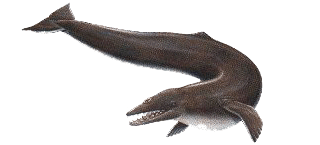
 |
| 60 in 70 million years... | 45 in 38 million years... |
| 55 million years... | Towards the current dolphin... |
 Archeoceti, ancestor of cetaceans |
All the ground mammals have for distant ancestors, fishes. On the contrary, cetaceans
should the only mammals to have be opted for a " return in the sea " complete. Cetaceans did not appear one day, as ca, accidentally. No, when the Earth becomes Earth and, much later, when the water forms the oceans, cetaceans are only in the state of project. Some billion years should again pass by between the appearance of the life in seas and arrival of their first ancestors. Event dates, roughly speaking 60 million years. |
| There is 60 in 70 million years... | |
| Seas, cleared of the big aquatic reptiles, are always occupied with fishes, which
survive together with cephalopods: octopuses, squids, cuttlefishes... On the continent, the mammals relegated to secondary roles by the big dinosaurs, replace them gradually. Whereas seem first primates, curious one quadruped mammal looking like a wolf, Mesonyx, evolved on banks lagunaires surrounding the primitive Mediterranean Sea, Téthys. It is the boss of banks. |
 Mesonyx |
 Mesonychide's skeleton |
Mesonyx is a quadruped of average size, in the skin covered with hairs, their paws in
five fingers are not armed with claws but with sturdy nails. It is of the water that they pull the main thing of their subsistence. It is so towards it that
they turn around it when level goes back up to the point to invade lands appeared, dominated with the other mammals. At first amphibian, this family evolved gradually towards more aquatic characters. The various parts of the body adapt themselves to an aquatic way of life: adaptation by swimming ex-members, regression of the posterior members, modification of the tail, which flattens and becomes the main means of drive, then the progressive recession of nostrils towards the summit of the skull, to allow to breathe while keeping the possibility of seeing under the surface of the water. |
| There is 55 million years... | |
| We attend a fast and spectacular modification of the morphology of archeocetes,
ancestors of cetaceans. Some fossils give evidence of these alterations : Pakicetus, of which the skull, discovered in Pakistan, reveals the presence of a
bubble tympanique, is well the proof of the adaptation of hearing to the navy life. The ambulocetus, sort of old huge otter of 52 million years, measures until 3 metres and weighs 300 kg. It is only between 45 and 40 million years that some of them free themselves from the nearness of the bank to conquer seas. |
 Ambulocetus |
| There is 45 in 38 million years... |
|
 Zeuglodon |
Zeuglodon, first known under the name of Basilosaurus, in Greek " king of lizards " possesses teeth in different
functions, canine, incisive and molars, inheritance of a ground custom, while they are identical at the current odontoces. Long from 15 to 20 metres for a
middle weight of 5 tons, it goes hunting along coasts in shallow water and reproduces on land. The skeleton shows of minuscles posterior members in net
regression. Vestiges of the reptiles, vertebras are not yet welded. The swimming of these animals doubtless had to look like that of snakes. Most of the current
cetaceans possess reduced, stiffened cervical vertebras, even welded, in differences of the ground animals.
In this way, the powerful beatings of the tail fin do not compromise the adaptation of the head during the swimming.
|
|
There is 40 in 35 million years seem several types of archeocetes evolved. These last ones prefigure the modern
cetaceans as for the silhouette and for the size. The last one archeocete Kekenodon, regular visitor to the coasts of New Zealand, disappears he has there 30
million years.
|
|